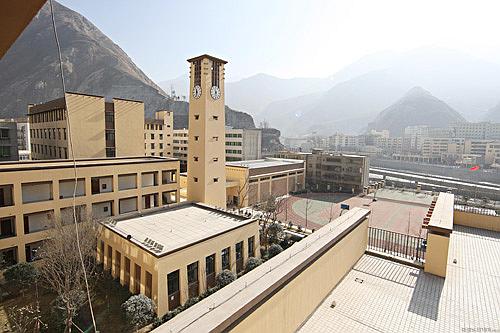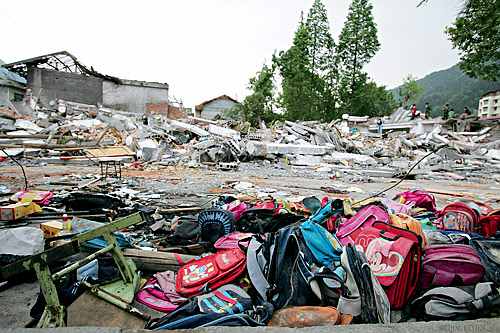|
 |
|
FORTIFIED: Buildings at the Wenchuan No.2 Primary School compound in Sichuan Province have been rebuilt with new vibration-minimizing cushion technology (ZHAO XI) |
 |
|
TRAGIC SCENE: The ruins of a primary school in Hongbai Town, Shifang City, after the Wenchuan earthquake, on May 18, 2008 (CFP) |
Authorities in charge of rebuilding the area leveled by the 2008 Wenchuan earthquake in Sichuan Province are focusing on mitigating future disasters while they are still planning and completing reconstruction projects, an official in charge of the reconstruction work said.
"Safety is what the public is most concerned about," said Xu Minggui, Director of the Project Coordination Department of the Reconstruction Aid Front Working Group of Guangzhou City, Guangdong Province. He said all the schools being rebuilt by Guangzhou will withstand stronger earthquakes. The Wenchuan No.2 Primary School, for example, has been rebuilt with rubber cushions to quell vibration. The technology was developed at a Guangzhou University laboratory.
The cushioning technology is being deployed for the first time in China, though it is commonly used around the world, said Xu. He said that separating the upper part of a structure from its base using the cushion could deplete the force of seismic waves when an earthquake occurs.
Cushions can be used up to 50 years before being replaced. "Vibration isolation can be enhanced by several degrees, but taking into consideration the construction technologies and the performance of materials, we are expecting one-degree higher efficiency in design," Xu said.
Zhou Fulin, an academician with the Chinese Academy of Engineering and a well-known expert in seismic isolation control, created the cushion. Zhou has paid frequent visits to Wenchuan to guide the project as an engineering consultant for the Guangzhou reconstruction aid team.
After nearly 30 years of research and development, the seismic isolation technology has become mature and ready for use. Three six-story residential buildings in Wudu County, Gansu Province, were equipped with the first generation of seismic isolation technology developed by Zhou in the 1990s and held up to the deadly May 12 earthquake in 2008. In fact, they escaped the destruction without a crack. The first quake-resistant railway bridge Zhou designed in Xinjiang Uygur Autonomous Region also survived the 2003 Jiashi earthquake and played an important role in transporting disaster relief supplies when roads had been severely damaged.
By employing the new technology, approach slabs for seismic isolation were used when reconstructing the Wenchuan No.2 Primary School. These approach slabs serve as passageways between buildings, which can keep them apart and can also reduce the force of earthquakes.
The Wenchuan No.2 Primary School uses modern architecture in the Qiang ethnic minority style. The vibration-isolation cushion in the building can be seen through windows to make local people aware of the technology.
In addition to the primary school, the technology was deployed in the first group of permanent buildings reconstructed after the May 12 earthquake, which were put into use at the end of 2009. Guangzhou University has now put the seismic isolation design into more than 20 buildings that are home to over 30,000 families in Weizhou, Wenchuan County.
What Is Rubber Cushion Technology?
The rubber cushion technology that isolates and reduces vibration is put at the base of buildings. It uses layers of steel plate and rubber stacked on top of each other like a sandwich. During an earthquake, the building slides on the rubber cushions, which both isolates vibration and holds the building up.
(Source: nanfangdaily.com.cn)
| 